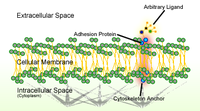
Photo from wikipedia
Simple Summary The use of probiotics to ameliorate skin conditions has been suggested. This is based in the fact that they compete with pathogenic bacteria for adhesion sites, thereby displacing… Click to show full abstract
Simple Summary The use of probiotics to ameliorate skin conditions has been suggested. This is based in the fact that they compete with pathogenic bacteria for adhesion sites, thereby displacing unwanted microorganisms. Lacticaseibacillus rhamnosus was able to adhere effectively to keratinocytes decreasing the number of adherent pathogenic bacteria. In the presence of pathogens all tested probiotics decreased invasion by S. aureus, one of the most relevant skin pathogens. Ex vivo models also showed wound healing capacity of L. rhamnosus with a concomitant decrease in the viable numbers of S. aureus, suggesting it is a good candidate as a co-adjuvant in the treatment of skin infections by this pathogen. Abstract The effects of probiotics on the skin are not yet well understood. Their topical application and benefits derived thereafter have recently been investigated. Improvements in different skin disorders such as atopic dermatitis, acne, eczema, and psoriasis after their use have, however, been reported. One of the mechanisms through which such benefits are documented is by inhibiting colonization by skin pathogens. Bacterial adhesion is the first step for colonization to occur; therefore, to avoid pathogenic colonization, inhibiting adhesion is crucial. In this study, invasion and adhesion studies have been carried out using keratinocytes. These showed that Escherichia coli is not able to invade skin keratinocytes, but adhered to them. Lacticaseibacillus rhamnosus and Propioniferax innocua decreased the viable counts of the three pathogens under study. L. rhamnosus significantly inhibited S. aureus adhesion. P. innocua did not inhibit pathogenic bacteria adhesion, but when added simultaneously with S. aureus (competition assay) a significant adhesion reduction (1.12 ± 0.14 log10CFU/mL) was observed. Probiotic bacteria seem to use carbohydrates to adhere to the keratinocytes, while S. aureus uses proteins. Lacticaseibacillus rhamnosus showed promising results in pathogen inhibition in both in vitro and ex vivo experiments and can potentially be used as a reinforcement of conventional therapies for skin dysbiosis.
Journal Title: Biology
Year Published: 2022
Link to full text (if available)
Share on Social Media: Sign Up to like & get
recommendations!